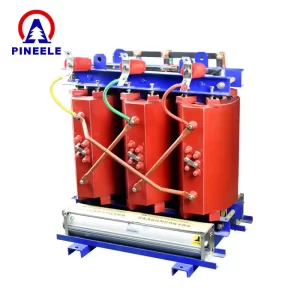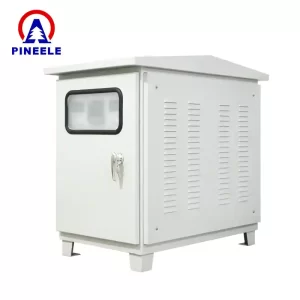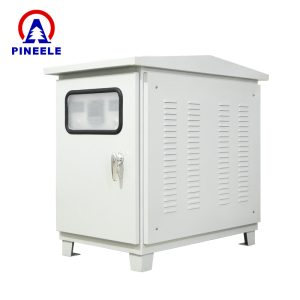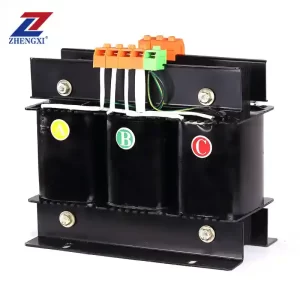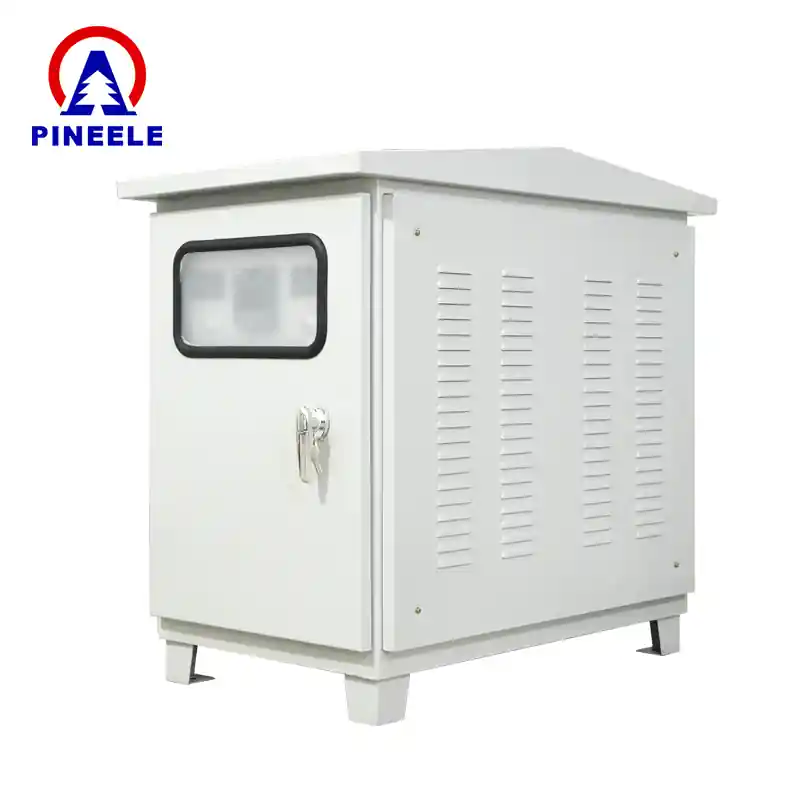
Dry Type Transformer
Dry Type Transformer is a highly efficient and safe power distribution solution widely used in industrial, commercial, and utility applications. Unlike traditional oil-immersed transformers, this type of transformer uses air or epoxy resin for insulation, eliminating the risk of oil leaks, fire hazards, and environmental pollution. It provides a clean, fire-resistant, and eco-friendly alternative for electrical networks.
With its advanced insulation system, the Dry Type Transformer offers superior thermal performance, high dielectric strength, and excellent mechanical durability. These transformers are specifically designed for indoor installations where fire safety, low maintenance, and space-saving are key requirements. Their ability to operate in extreme conditions makes them ideal for power substations, industrial plants, high-rise buildings, hospitals, data centers, and renewable energy applications.
Additionally, the advanced cooling mechanisms in Dry Type Transformers, such as natural air cooling (AN) or forced air cooling (AF), enhance energy efficiency while reducing operational costs. Their robust design eliminates the need for oil-based cooling, making them an environmentally sustainable choice.
With its strong focus on safety, efficiency, and environmental sustainability, the Dry Type Transformer continues to be a leading choice for modern power distribution systems. Whether for industrial use, commercial facilities, or urban electrical networks, this transformer offers a future-ready solution for clean and reliable energy transmission.
What is a Dry-Type Transformer?
A Dry-Type Transformer is an electrical power transformer that uses air or solid insulation instead of oil or liquid for cooling and insulation. This design eliminates the risk of leaks, fire hazards, and environmental contamination, making it a safer and more sustainable choice for power distribution.
Unlike traditional liquid-filled transformers, dry-type models rely on natural air circulation or fans to dissipate heat. They are commonly used in industrial, commercial, and renewable energy applications where fire safety, reliability, and low maintenance are priorities.
Dry-type transformers are available in different configurations, including ventilated, encapsulated, and totally enclosed designs. Each type is tailored to specific operational conditions, from clean indoor environments to harsh industrial settings.
With advantages such as enhanced energy efficiency, minimal environmental impact, and extended lifespan, dry-type transformers have become essential in modern electrical infrastructure.
These transformers also support smart grid technology, offering advanced monitoring and automation features that enhance power system stability and efficiency.
Three-Phase Dry-Type Transformer
Product Overview
The Three-Phase Dry-Type Transformer is a highly efficient and environmentally friendly power distribution solution widely used in industrial, commercial, and residential applications. Unlike traditional oil-immersed transformers, this dry-type unit eliminates the risk of oil leaks, fire hazards, and pollution. It offers superior thermal performance, excellent dielectric strength, and low maintenance requirements, making it an ideal choice for indoor installations where safety, reliability, and energy efficiency are top priorities.
Key Features
- High Efficiency & Low Loss: Designed with advanced insulation and core materials, this transformer ensures minimal energy loss and achieves an efficiency of up to 98%, significantly reducing operational costs.
- Compact & Modular Design: Its space-saving structure allows for easy installation in constrained areas, making it ideal for use in high-density urban power distribution systems and industrial plants.
- Enhanced Safety & Fire Resistance: Without oil as an insulating medium, the transformer eliminates the risks of leaks and combustion, making it highly resistant to fire and environmental hazards.
- Reliable Performance & Long Service Life: With high-quality insulation materials and a robust structure, the transformer has a design lifespan of over 30 years, ensuring stable and continuous power distribution.
- Customizable Input & Output Voltage: Configurable voltage levels to meet different customer requirements for specific applications, ensuring compatibility with diverse power grids and equipment.
- Smart Grid Integration: Compatible with modern automation and remote monitoring systems, enabling real-time diagnostics, fault detection, and load optimization to improve power distribution efficiency.
- Eco-Friendly & Low Noise Operation: The dry-type design produces noise levels as low as ≤35dB, making it suitable for noise-sensitive environments such as office buildings, hospitals, and educational institutions.
- Rugged Construction for Harsh Environments: Designed to withstand extreme operating conditions, including high humidity, dust, and temperature variations, ensuring reliable operation in industrial and outdoor settings.
Technical Specifications
- Phase: Three-Phase, ensuring balanced power distribution for industrial and commercial applications.
- Capacity Range: 0.5KVA - 2000KVA, suitable for small-scale to large industrial power systems.
- Input Voltage: Customizable according to client requirements, allowing integration into various national and regional power systems.
- Output Voltage: Custom-configured to meet different application demands, ensuring voltage stability and compatibility.
- Voltage Accuracy: ±1% precision control for stable power output, reducing fluctuations and enhancing equipment lifespan.
- Voltage Regulation Rate: ≤1.5%, ensuring minimal deviations in output voltage under varying load conditions.
- Insulation Class: Available in Class F, Class H, and HC, with Class F as the standard option to ensure optimal thermal performance.
- IP Protection Rating: IP00, IP20 (customizable), offering protection against dust, accidental contact, and harsh environmental conditions.
- Frequency: 50/60Hz, adaptable for global power networks.
- Overload Capacity: Capable of operating at 1.2 times the rated load for up to 4 hours without performance degradation.
- Temperature Rise: ≤60℃, ensuring safe and efficient operation without excessive heat buildup.
- Insulation Resistance: ≥150MΩ, ensuring electrical safety and preventing insulation failures.
- Cooling Method: Air Cooling (natural or forced), maintaining optimal operating temperature without the need for liquid cooling mediums.
Operating Conditions
- Altitude Limit: Suitable for installations up to 2000m above sea level, ensuring reliable operation in mountainous and high-altitude regions.
- Temperature Tolerance: Operates efficiently in environments ranging from -20℃ to +45℃, making it suitable for both extreme cold and hot climates.
- Humidity Resistance: Can withstand up to 90% relative humidity at lower temperatures, ensuring stability in damp conditions.
- Seismic & Vibration Resistance: Designed to withstand mild seismic activity and mechanical vibrations, making it ideal for industrial and high-risk locations.
- Non-Explosive & Corrosive-Free Environment: Not recommended for installations in environments containing flammable gases, corrosive chemicals, or conductive dust.
Common Applications
- Industrial Facilities: Provides stable and reliable power to factories, manufacturing plants, and production lines, ensuring uninterrupted operations.
- Commercial Buildings: Used in office towers, shopping malls, and data centers to maintain stable voltage for critical systems.
- Renewable Energy Systems: Integrated into solar and wind power stations for efficient energy conversion and grid stability.
- Hospitals & Educational Institutions: Ensures clean, stable power for sensitive medical and research equipment.
- Power Substations & Distribution Networks: Plays a crucial role in power transmission, ensuring reliable voltage regulation and distribution.
Product Variants & Dimensions
Available in multiple configurations to meet various installation and operational requirements. Standard models include:
- Small Capacity Models (1.5KVA - 15KVA): Compact and lightweight, ideal for localized power distribution and specialized industrial applications.
- Medium Capacity Models (20KVA - 50KVA): Used in small industrial plants and high-demand commercial facilities.
- Large Capacity Models (100KVA - 2000KVA): Designed for high-power industrial operations, substations, and renewable energy integration.
The Three-Phase Dry-Type Transformer is a reliable, efficient, and eco-friendly power distribution solution. With advanced fire resistance, minimal maintenance, and excellent operational efficiency, it is the ideal choice for industrial, commercial, and critical infrastructure applications. Whether used in high-rise buildings, renewable energy grids, or industrial power systems, it ensures a stable, safe, and cost-effective power supply, supporting modern energy demands and future technological advancements.


